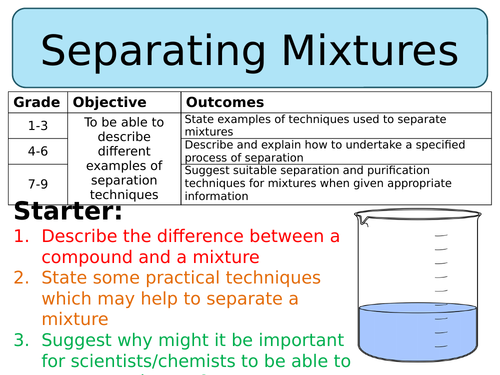
This lesson is designed for the NEW AQA Chemistry GCSE, particularly the 'Atomic Structure & Periodic Table' SoW.
For more lessons designed to meet specification points for the NEW AQA Trilogy specifications for Biology, Chemistry and Physics please see my shop: https://www.tes.com/teaching-resources/shop/SWiftScience
This lesson begins with a reminder of what a mixture is and a list of key words related to this topics, pupils are asked to think > pair > share ideas about the definition of these key words. After a class discussion pupils are asked to link these terms, with examples, to the correct definition. Once finished they can self-assess this work.
Pupils will then watch a video about different separation techniques and will be required to answer questions whilst watching, after this work is self-assess pupils will explore these methods further by completing a table of information using posters around the room.
The final activity is a practical to show how chromatography works, pupils will complete this practical (should only take 10-15 minutes) and then will be introduced to Rf values, they can use this calculation to work out the Rf values of the dyes they have separated during the practical.
The plenary task is for pupils to summarise what they have learnt during the lesson by using as many key words from the key word list as possible.
All resources are included at the end of the presentation. Thanks for looking, if you have any questions please let me know in the comments section and any feedback would be appreciated :)
For more lessons designed to meet specification points for the NEW AQA Trilogy specifications for Biology, Chemistry and Physics please see my shop: https://www.tes.com/teaching-resources/shop/SWiftScience
This lesson begins with a reminder of what a mixture is and a list of key words related to this topics, pupils are asked to think > pair > share ideas about the definition of these key words. After a class discussion pupils are asked to link these terms, with examples, to the correct definition. Once finished they can self-assess this work.
Pupils will then watch a video about different separation techniques and will be required to answer questions whilst watching, after this work is self-assess pupils will explore these methods further by completing a table of information using posters around the room.
The final activity is a practical to show how chromatography works, pupils will complete this practical (should only take 10-15 minutes) and then will be introduced to Rf values, they can use this calculation to work out the Rf values of the dyes they have separated during the practical.
The plenary task is for pupils to summarise what they have learnt during the lesson by using as many key words from the key word list as possible.
All resources are included at the end of the presentation. Thanks for looking, if you have any questions please let me know in the comments section and any feedback would be appreciated :)
Get this resource as part of a bundle and save up to 50%
A bundle is a package of resources grouped together to teach a particular topic, or a series of lessons, in one place.
Something went wrong, please try again later.
Great resource! Very straightforward!
Report this resourceto let us know if it violates our terms and conditions.
Our customer service team will review your report and will be in touch.
£3.00
